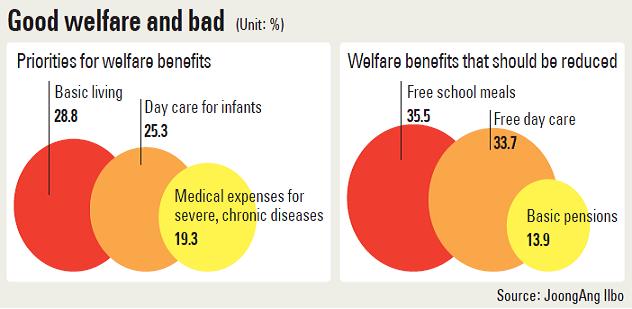Welfare is going to the wrong people, says poll

But in March 2010, he went to a hospital to treat sores in his mouth and was diagnosed with Behcet’s disease, a rare, incurable disease. The symptoms got more severe over time and he was rushed to the emergency room at increasing intervals. He was forced to quit work at the end of 2012 and went blind in his left eye due to the disease. His doctor recommended a drug called Remicade. The medication worked.
But it was expensive. Each shot cost 2 million won and it wasn’t covered by his health insurance. Kang has received 10 injections so far. In the meantime, his parents lost their jobs while concentrating on nursing him. Kang eventually fell so low as to become a recipient for the basic livelihood welfare payment in 2013, just three years after he was diagnosed with the disease that has turned his life upside down.
“I heard the drug is covered by health insurance in Japan,” he asks. “How come it isn’t in Korea?”
Kang is one of numerous Koreans who have found themselves in a blind spot in the Korean welfare system. His situation hasn’t improved even though the Korean government has set aside a massive 116 trillion won for welfare this year, up 6 trillion won from the previous year.
A survey by the JoongAng Ilbo of both 1,000 adults nationwide and 60 welfare experts from Thursday to Friday showed that the first priority for new spending on welfare in Korea should be helping people like Kang who find themselves in a blind spot under the current system. Of the general public surveyed, 25.8 percent said that should be the main priority, and 56.7 percent of the experts agreed.
In fact, the government has been extremely stingy helping people in the lower-income brackets - spending just 20 trillion won on them last year.
Choi Jin-ho, professor of sociology at Ajou University, says that even though the government has more than doubled its welfare budget in the past decade, low-income groups lost out.
“As the government concentrated on general welfare benefits such as free meals at school or free day care, the welfare gap between different social brackets according to income has grown bigger,” he says.
The number of people who received basic living benefits peaked at 1.57 million in 2009 and fell to 1.33 million last January. But the number of people below the poverty line yet not eligible for the minimum protection totals 1.85 million. The poll also showed that the public and experts agree that the second priority for welfare policies should be day care for infants. Among the general public, 25.3 percent agreed with that and 26.7 percent of the experts affirmed.
“Dragging up Korea’s low birth rate by stepping up day care services is crucial,” says Cho Jae-guk, professor of public health and medical administration at Dongyang University. “The government should focus more on building infrastructure for national and public day care centers.”
Over 62 percent of all respondents said the level of welfare in Korea is insufficient and 28.4 percent said more benefits should be earmarked for lower-income groups. Almost 20 percent of the respondents said that Korea is providing excessive levels of welfare benefits. Some 35.5 percent said free school meals should be scaled back, followed by free day care at 33.7 percent and basic pensions at 13.9 percent.
BY SPECIAL REPORTING TEAM [spring@joongang.co.kr]










with the Korea JoongAng Daily
To write comments, please log in to one of the accounts.
Standards Board Policy (0/250자)